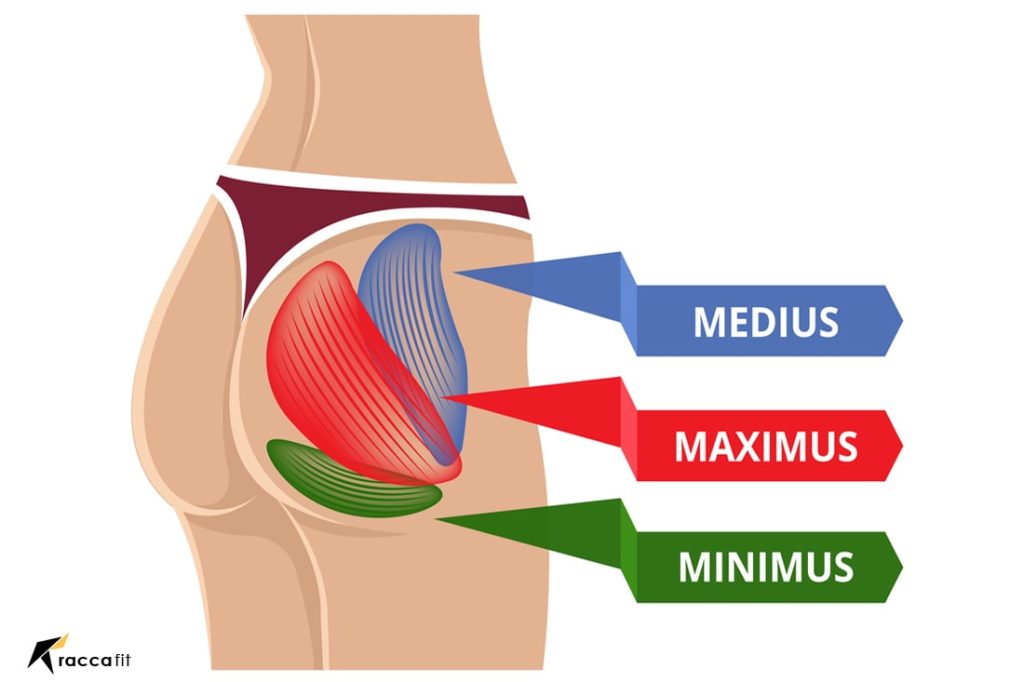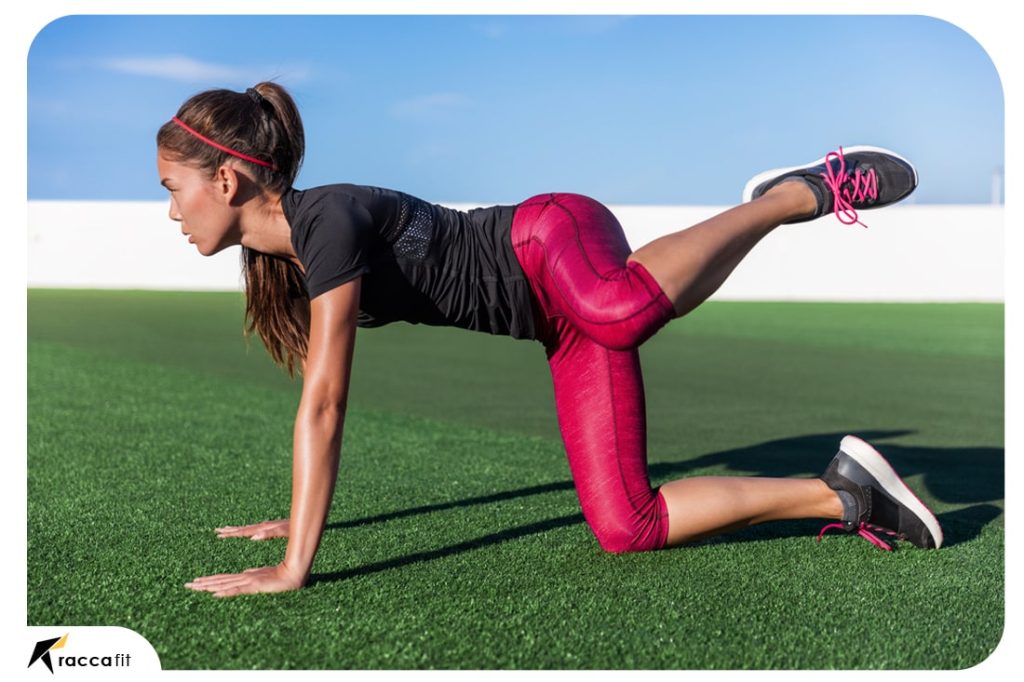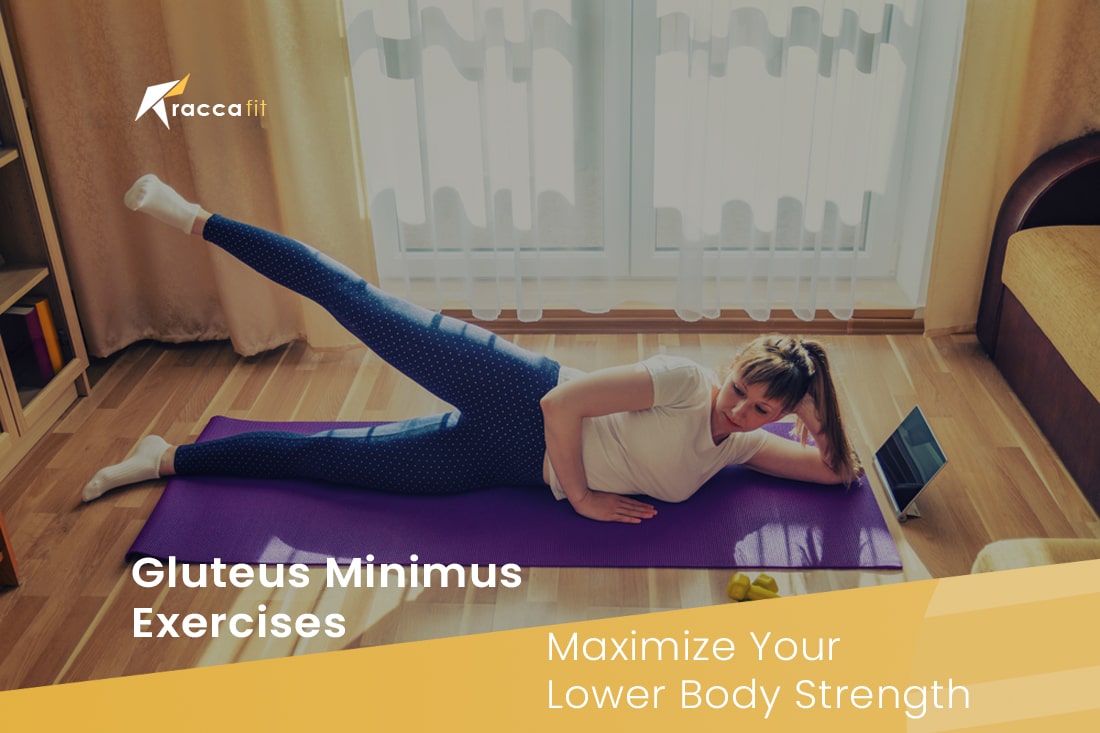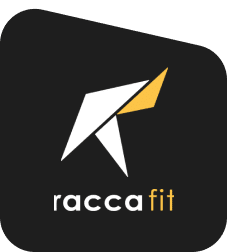This comprehensive guide provides an in-depth exploration of the Gluteus Minimus Exercises, its functions, its importance, and the most effective exercises to keep it strong and healthy. Equipped with this valuable information. You will possess the capability to unleash the concealed potential of your gluteus minimus, which will enhance your abilities and elevate your overall well being significantly. So, let’s take the road less traveled and give this unsung hero the attention it truly deserves.
Step into any gym or fitness center, and you’re likely to encounter a crowd focused on building their biceps, triceps, or flaunting their perfectly chiseled abs. While these muscle groups are certainly important, many people overlook the smaller, less glamourous muscles that play crucial roles in our body’s overall function and stability. Among these underrated heroes is the gluteus minimus, the smallest of the gluteal muscles, which is nestled deep within our buttocks.
Despite its modest size, the gluteus minimus carries the weight of various responsibilities that contribute to our daily movements and athletic abilities. From assisting us in taking confident strides, making swift changes in direction, to maintaining our upright posture, the gluteus minimus is there, working tirelessly behind the scenes.
Unfortunately, this muscle group often goes unnoticed until it’s strained or injured, at which point the impact on mobility becomes all too apparent. Therefore, it’s important to integrate focused exercises that target and strengthen the gluteus minimus into your fitness routine.
The question then arises, how do we efficiently and effectively do the Gluteus Minimus Exercises? Which exercises help strengthen this little yet powerful muscle? How does it impact our overall fitness levels, and why is it crucial to maintain its health?
Understanding the Gluteus Minimus
Our muscular system relies on the crucial contribution of various muscles working together including the small yet significant role played by the gluteus minimus, which is amongst the three primary muscles located within our glutes. Hidden beneath layers of other muscles, this powerhouse is deeply nested within our buttocks, yet it shoulders the critical responsibility of helping us maintain stability and maneuverability.
The Function of the Gluteus Minimus Explained
The gluteus minimus is a hard worker when it comes to keeping our bodies in motion. Predominantly, it’s responsible for hip abduction, a fancy term for moving your leg away from your body’s center. It’s a motion we frequently perform, whether we’re stepping sideways, crossing our legs, or even just adjusting our stance.
Furthermore, it has a crucial role in the internal rotation of the hip. If you’ve ever pivoted on your foot to change directions suddenly, you’ve relied on your gluteus minimus. Additionally, this muscle works as a silent guardian that stabilizes our pelvis as we walk or run, ensuring we maintain balance and preventing any awkward trips or falls. With such a multi-faceted functionality, it becomes clear why taking care of this small but mighty muscle is crucial.
The Vital Importance of Strengthening the Gluteus Minimus
Boosting Overall Fitness Levels
Our bodys’ fitness machinery comprises various parts, including the gluteus minimus – a muscle that may appear small but contributes significantly to physical health. Just like a cog in a wheel it plays an essential role and cannot be overlooked. By strengthening it, you’re improving your balance, agility, and coordination. Beyond sports performance these attributes have practical applications for everyday life as well. For example you might find that having them makes it easier to climb stairs or stand up from a chair without strain. Even navigating unpredictable terrain becomes less of a challenge.
Moreover, a well-toned gluteus minimus aids in sculpting a stronger and better-looking physique. It enhances the shape and firmness of your buttocks, contributing to an attractive, toned appearance. So, whether you’re wearing your favorite pair of jeans or workout gear, a strong gluteus minimus can boost your confidence and style.
Learn More: Hip Flexor Exercises with Bands: Supercharge Your Flexibility!
Preventing Injuries by Strengthening Gluteus Minimus
A fortified gluteus minimus is like a shield against potential injuries. It plays a significant role in maintaining the correct posture by aligning your lower body properly. An aligned body reduces the strain on your back, hip, and knee joints, thus reducing the risk of associated injuries.
This is especially important if you engage in high-impact activities or sports. A stronger gluteus minimus will offer better stability, helping to prevent injuries that could sideline you from your favorite activities.

Anatomy of the Gluteus Minimus: A Closer Look
Location and Structure of the Gluteus Minimus
Resting deep within our buttocks resides one significant muscle known as our gluteus minimus. It lies below both our gluteal medius as well as our maximus muscles despite possessing a name that implies smaller proportions. However, this particular structure actually adopts a unique fan-like shape which expands widely across an extensive section of our hip bones – originating distinctly at our largest component; characterized by ilium- before concluding where it inserts itself onto topmost part or head-neck junction region on or femur or the thigh bone. Its strategic location and unique structure equip it with the leverage it needs to perform its duties.
Understanding Its Relationship with Other Muscles
Like a well-oiled machine, our muscular system thrives on synergy. The gluteus minimus does not work alone; it collaborates closely with its neighboring muscles to facilitate smooth and efficient movement. In particular, its function overlaps with the gluteus medius and maximus in executing hip abduction and rotation. Recognizing these connections highlights the importance of a holistic approach to fitness that promotes overall muscular balance and harmony.

Five Effective Exercises to Strengthen the Gluteus Minimus
While general lower body exercises are beneficial, if you want to specifically target and strengthen your gluteus minimus, you need to integrate exercises that isolate this muscle into your fitness routine. Here are five effective exercises that can help you do just that.
Side-Lying Hip Abduction: Lifting Your Way to a Stronger Gluteus Minimus
This simple yet effective exercise involves lying on your side and lifting your upper leg while keeping it straight. This movement targets the gluteus minimus directly, making it an excellent exercise for toning and strengthening this muscle.
Start by laying on your side with your legs stacked and your head resting on your arm. Then, while keeping your legs straight, lift your top leg towards the ceiling, ensuring to keep the movement controlled. Lower your leg slowly, then repeat the exercise. Aim for 10-15 reps per set and switch sides to ensure you target both muscles equally.
Standing Hip Abduction: Strengthening Your Muscle One Lift at a Time
Standing hip abduction is a straightforward exercise that’s easy to incorporate into your routine. Achieving an effective workout is feasible by utilizing limited space and solely relying on the weight of your body.
Start by standing up straight, holding onto a wall or chair for support if necessary. With grace and composure. Hoist up your right limb sideways and maintain its straightness throughout. Meanwhile. Take precautions not to lean excessively towards the left so as not to compromise on stability. After that. Gradually descend your right leg back down to its original spot prior to repeating with the other (left) limb. Aim for 10-15 reps on each side for a full set.
Learn More: Bird dog exercise: Comprehensive guide and video tutorial
Seated Hip Abduction: Machine-Assisted Muscle Building
This exercise requires a gym machine, but it’s a great way to target the gluteus minimus directly. The seated hip abduction machine applies resistance, forcing your muscles to work harder and therefore strengthening them more effectively.
Start by sitting on the machine with your legs together and your feet on the provided footrests. Push your legs apart against the machine’s resistance, then slowly bring them back together. Aim for 10-15 reps for a full set. Remember to adjust the machine’s weight to a level that is challenging but still allows you to maintain good form.
Clamshells: Mimicking Nature for Better Fitness
This exercise is named after the movement that it mimics: the opening and closing of a clamshell. It’s a fun and effective exercise for targeting the gluteus minimus and medius.
To start this activity lie down on either left or right lateral position based on personal preference. Subsequently position both hips and knees in a flexed state where they approximate an angle of roughly forty five degrees. In addition. Elevate one limb over the other while also aligning both feet parallel with your spine structure. Keeping your feet touching, raise your upper knee as high as you can without shifting your hips or lower back. Then, slowly lower your knee back to the starting position and repeat. Aim for 10-15 reps on each side.
Fire Hydrants: An Exercise with a Quirky Twist
Despite its unusual name, the fire hydrant is a serious exercise that provides a solid workout for the gluteus minimus. This movement mimics the action of a dog at a fire hydrant, hence its name.
At first. Ensure that both of your hands are placed underneath shoulder level. While keeping both of your knees at hip level as well. Proceed with bending one knee prior to lifting its corresponding leg out towards any lateral side until it becomes completely parallel to the ground surface. After this. Try repeating these moves utilizing opposite limbs for greater results. Aim for 10-15 reps on each side. You can check our Fire Hydrant Exercise article for more information
Tips to Enhance the Exercise Effectiveness
With these exercises as part of your fitness routine. You are on track towards a more powerful gluteus minimus exercises. However for optimal outcomes keep these tips at the forefront of your mind.
Importance of Proper Form
Proper form is critical when performing these exercises. Ensure that you’re isolating the gluteus minimus and not compensating with other muscles. For example, when performing the side-lying hip abduction, focus on keeping your body aligned and avoid rolling your hips backward or forward. By focusing on feeling the burn solely in your gluteus minimus during exercise you can prevent uncomfortable sensations from occurring in other bodily areas such as your back.
Consistency Is Key
Like any other fitness goal, consistency is vital when it comes to strengthening the gluteus minimus. Make it your objective to perform these specific exercises no less than twice or thrice each week. And constantly remind yourself that its best to execute a smaller number of accurate reps than attempting numerous reps with substandard technique.

The Role of Diet in Muscle Building
Bear in mind that optimal nutrition is integral to developing and fortifying your muscles as you commence these exercises. For instance, your muscles require energy supply for optimal functionality during exercise, while essential nutrients aid their recovery and growth after each workout.
Balanced Nutrition: The Foundation of Muscle Building
Ensure your diet includes plenty of proteins, as they’re the building blocks of muscle tissue. However, don’t neglect your carbohydrates and fats. Sustaining peak performance during exercise is only possible with sufficient carbohydrate intake. Additionally. Dietary fats serve an integral purpose in facilitating critical processes such as nutrient absorption.
Hydration: The Unsung Hero of Fitness
Staying hydrated is also crucial when performing physical activities. Water aids in various bodily functions, including the transportation of nutrients, which is critical for muscle health. Plus, staying hydrated can help keep your energy levels up, allowing you to perform better during your workouts.
Learn More: 14 Day Liquid Diet Weight Loss Plan: Lose 10 Pounds in 14 Day
Signs of a Weak Gluteus Minimus
When it comes to our bodies, vigilance can be a virtue. Understanding the signs of a weak gluteus minimus is critical to spotting potential problems before they escalate, and taking timely corrective action. It’s crucial to recognize these signs, as they are indicative of your body’s cry for help, signaling that it’s time to strengthen this essential muscle.
Common Symptoms of Gluteus Minimus Weakness
A weak gluteus minimus may not always make its presence known through glaringly obvious symptoms, but several subtle signs can provide valuable clues about this condition. It’s important to stay alert to these hints, as they offer the opportunity to tackle the issue head-on and prevent further complications.
One of the common symptoms of a weak gluteus minimus is difficulty in performing tasks that require hip abduction, such as stepping sideways, crossing one leg over the other, or even standing on one leg. If you notice a decrease in your ability to perform these simple tasks, it could be indicative of a weak gluteus minimus.
You might also observe a lack of stability in your hips, especially when you’re standing on one leg. This is because the gluteus minimus plays a critical role in stabilizing the pelvis, and a weakness in this muscle can disrupt that balance, leading to instability.
Another symptom of a weak gluteus minimus is experiencing discomfort around the hip area, particularly during or after physical activities. This discomfort can manifest as a dull ache or even sharp pain, and it can extend to your thigh and even your knee. This occurs as the body forces other muscles to overcompensate for the weakness in the gluteus minimus, leading to strain and discomfort in these areas.
Potential Consequences of Neglecting the Gluteus Minimus
Ignoring the signs of a weak gluteus minimus doesn’t just affect your physical performance, it can also set the stage for a host of complications. When you neglect this crucial muscle, it can lead to several negative consequences. These may include an increased risk of injuries, such as hip impingement, hip labral tears, and lower back pain, as the body grapples with the lack of support from the weakened gluteus minimus.
Over time, the weakness can contribute to postural problems. The gluteus minimus plays a vital role in maintaining the alignment of your hips and lower body. A weak gluteus minimus can result in a disruption of this alignment, leading to an imbalance in the body’s musculoskeletal system.
Furthermore, a weak gluteus minimus could also affect your walking gait. As the muscle helps with the internal rotation of the hip, its weakness could lead to a lack of smoothness in your steps, which over time could cause discomfort or injury.
Common Mistakes When Training the Gluteus Minimus
When setting out on the journey to strengthen the gluteus minimus, there are some common pitfalls that individuals often stumble into. These mistakes can slow your progress, diminish the effectiveness of your efforts, and even pave the way for potential injuries. Awareness and understanding of these mistakes are the first steps towards avoiding them.
Overcompensation by Other Muscles
One of the most frequently seen mistakes is allowing other, stronger muscles to take over the work intended for the gluteus minimus. This phenomenon, known as overcompensation, typically happens subconsciously. We often lean on our stronger muscles, inadvertently leaving the gluteus minimus under-stimulated and weak.
This issue can be particularly prevalent in exercises like the side-lying hip abduction or clamshells, where it’s easy for the larger, more dominant muscles such as the gluteus maximus or the quadriceps to take over. This results in the gluteus minimus not receiving the targeted workout it needs to strengthen and grow.
To avoid this mistake, it requires a conscious effort to focus on engaging the correct muscle during each exercise. This might involve performing the movements slower and really concentrating on the muscle you’re trying to work. Visualization techniques can also be useful. For example, imagining the gluteus minimus engaging and working as you perform the movements can help ensure that the right muscle is being targeted.
Neglecting Proper Form
Another common pitfall is neglecting the importance of proper form during the exercises. Proper form is not just about looking good; it’s about ensuring that the movement effectively targets the intended muscle group and prevents injuries. Poor form can lead to inefficiencies in your workout, with the exercise failing to adequately target the gluteus minimus. It also puts undue strain on other parts of your body, increasing the risk of injuries.
For example, in exercises such as the side-lying hip abduction or standing hip abduction, maintaining the correct body alignment is crucial. It’s essential to avoid swinging your leg or leaning your body too far to the side. Instead, the movement should be controlled and deliberate. Additionally, your body should be in a straight line, with your hips stacked to ensure that the gluteus minimus is effectively targeted.
One useful tip to maintain proper form is to perform exercises in front of a mirror, at least initially. This allows you to monitor your form and make necessary corrections.
By being aware of these common mistakes and making a concentrated effort to avoid them, you can make your journey towards a stronger gluteus minimus more effective and safe, paving the way for improved mobility, stability, and overall quality of life.
Conclusion
Strengthening the gluteus minimus is an important aspect of overall fitness that often goes overlooked. However, with targeted exercises and a balanced diet, you can effectively strengthen this critical muscle. Remember, consistency is key when it comes to muscle strengthening and toning, and a holistic approach that includes proper nutrition and hydration will bring about the best results.
Strengthening your gluteus minimus not only boosts your performance in physical activities and sports but also contributes to the overall shape and aesthetics of your physique. So, whether you’re an athlete looking to improve your agility or someone simply trying to stay fit and healthy, don’t underestimate the power of the small yet mighty gluteus minimus.
FAQs
- What is the role of the gluteus minimus muscle? The gluteus minimus helps in hip abduction, internal rotation, and stabilizes the pelvis during movement.
- What exercises target the gluteus minimus? Exercises like side-lying hip abduction, standing hip abduction, seated hip abduction, clamshells, and fire hydrants effectively target the gluteus minimus.
- How often should I perform gluteus minimus exercises? It’s recommended to perform these exercises 2-3 times per week, making them part of your balanced fitness routine.
- Can strengthening the gluteus minimus prevent injuries? Yes, a strong gluteus minimus can help maintain correct posture and alignment, reducing the risk of back, hip, and knee injuries.
- Does nutrition play a role in muscle strengthening? Yes, proper nutrition is crucial for muscle growth and recovery. Including sufficient protein, carbohydrates, and healthy fats in your diet can aid in muscle strengthening.








